French Clocks
Many of the finest French clocks had ébauche movements. Ebauche movements were machine made and unfinished. The clockmaker would finish making the clock entirely by hand, fitting the gears together between the plates, the escapement, the pendulum, the dial, the hands, to complete the clock. Ebauche movements had standard parts, as much as possible, to benefit from economies of scale. Frédéric Japy (1749 - 1813) began to manufacture ébauches by hand-operated machine tools in 1776. French Ebauche clocks would change little over the next 150 years, by the time production ceased around 1930.
The first clock on this page was made by Japy Frères, circa 1920. Most Ebauche clocks had no markings that showed who manufactured the clock, but several prominent makers, such as Japy, Marti, and Vincenti, marked their movements.
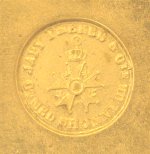 |
Only a professional should work on a French clock. Examples of this vintage often had strike mechanisms with a rack and a snail. Take extreme care when removing the gathering pallet.
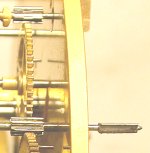 |
The escape wheel has very fine teeth that are very easily damaged. The pivots are very small, hard and brittle, making them difficult to polish.
 |
The movement must be taken apart for cleaning. The mainsprings must be removed with a mainspring winder for cleaning and inspection. Any visible damage means the mainspring must be repaired or replaced: a broken mainspring in a French clock often causes severe damage because of the fine teeth on the barrel.
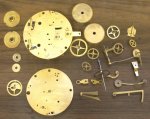
|
The strike mechanism is adjusted during assembly. The third wheel has just released the hammer when the detent lever gets in the path of the pin on the fourth wheel. The pin on the fifth wheel should be half a turn away from the warning lever when the pin on the fourth wheel rests against the detent lever.
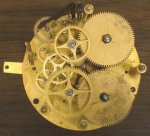 |
The snail should be positioned as shown for twelve o'clock when the minute hand is pointing to "60."
 |
Most clocks with Brocot escapements show the escapement in the dial. This clock has the Brocot pallets between the plates.

|
The majority of French ébauche movements, however, had the standard recoil escapement. Here is a recoil escapement from a clock by Vincenti, circa 1845. Its escape wheel has more teeth. The teeth are smaller and even more delicate!
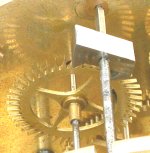 |
The older clocks did not have a rack and a snail in the strike mechanism. This Vincenti clock has a count wheel instead. Notice that the Vincenti clock also has a silk thread suspension, instead of a metal suspension spring.
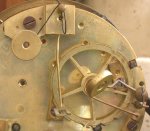 |
The marking makes the clockmaker readily identifiable and the clock more collectible.
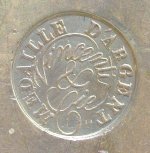 |
Here is an example of a pin wheel escapement in a magnificent French clock, circa 1780.
 |
While on the subject of escapements, here is an example of the oldest design in mechanical clock escapements, the verge with crown wheel.
Notice the contrate wheel and the fusées below. This clock is also from the 1700's, but a distinctly British design with Chinese writing on it, revealing the strong British influence in the Orient at that time. This exceptionally rare clock has a small pendulum directly attached to the verge on a knife-edge suspension.
Japy French Clock II
Clock Repair Main Page
Escapements in Motion
Links Page